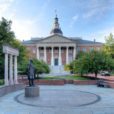Grassroots community organizing is and always has been at the heart of the environmental justice movement. In recent years, this organizing has led to state-level legislative successes across the nation, including expanding community engagement, developing equitable climate funding requirements, and establishing environmental justice task forces — yet there is still more work to be done. Closing the gap between grassroots organizers and the rest of the climate action community is an essential step in securing a truly just and equitable future for our planet.
July’s Deep Dive webinar focused on the environmental and climate organizations that are doing this hard work, highlighting their on-the-ground efforts to empower communities and emphasizing how other state actors can support this action. What can we learn from decades of grassroots environmental justice organizing? In what ways can we collaborate with frontline communities to develop long-term resilience to the climate crisis? How can we ground our work for state-level climate justice in true equity and community care?
To answer these questions and more were speakers from across the country with years of experience in organizing for environmental justice. Veronica Padilla-Campos, Executive Director at Pacoima Beautiful, shared her experiences fighting for a cleaner and safer environment in California’s Northeast San Fernando Valley. Kate McIntosh, Program Coordinator at Louisiana Bucket Brigade, discussed her work collaborating with frontline communities to push back petrochemical pollution. And Kortni Washington, our own State Climate Policy Fellow at Climate XChange, delved into the intersection of public health and environmental justice at the grassroots local and state levels.
Veronica Padilla-Campos, Executive Director at Pacoima Beautiful
Veronica Padilla-Campos grew up in Sun Valley, California, and now lives in Sylmar with her family. She also serves on the Governing Board for the South Coast Air Quality Management District, working to bring clean air across the region and give an additional voice to the environmental justice (EJ) communities bearing the burden of air pollution. As Executive Director of Pacoima Beautiful, Veronica is dedicated to improving the welfare of people by creating equitable, healthy, and safer communities.
Pacoima Beautiful (PB) is a grassroots EJ organization that provides education, advocates for local policy, and supports local arts and culture in order to promote a healthy and sustainable San Fernando Valley. Pacoima is a dense Los Angeles neighborhood located in the Northeast San Fernando Valley and is home to over 100,000 residents. The community is 85% Latino and 8% African American. Pacoima is labeled in the 90th percentile by CalEnviroScreen, the pollution burden mapping tool used by the state of California; this extremely high pollution burden is what motivates the PB team to push for environmental justice. The neighborhood experiences the cumulative impacts of railroad tracks, a municipal airport, autoparks, freeways, landfills, energy plants, and various other polluting sources in and around the area, creating major health issues for residents.
PB advocates for clean water, clean air, increased access to open spaces and trees, better housing, clean transportation, clean energy, and beyond, and the way they achieve these outcomes is by working closely with community residents. These residents, known as PB’s Community Inspectors, receive advocacy training and gain information on which entities, agencies, and regulators control different aspects of the issues they’re tackling and how to navigate them. Through this work, Community Inspectors become the eyes and ears for Pacoima, reporting issues and advocating for justice.
PB also specifically organizes for policy outcomes, such as Los Angeles’ Measure A, which increases opportunities for disadvantaged communities to access parks and open spaces. Parks are extremely important for all communities, especially in the San Fernando Valley. Summers are extremely hot, but not all residents have access to air conditioning, and if they do, many units are not energy efficient and the cost of running them is too high. PB has also advocated for state-level funding through California’s Transformative Climate Communities Program, organizing with a coalition of around eight groups as the Green Together Collaborative to receive a grant to transform their community. Community members drove this process, bringing the grant to the attention of PB and even traveling to Sacramento to make the case for their community. Locally, PB has also advocated for better employment at waste facilities; on el Día de los Muertos, residents went to City Hall with orange flowers to represent the lives lost by unsafe working conditions within the various waste hauling facilities in their community. Community members also do in-person outreach and engagement with other residents, such as informing them on the LA River and asking what needs and hopes they have for transforming the river, incorporating their feedback into the projects they work on.
PB has mobilized many community members as advocates, and Veronica chose to spotlight a few of them. Sofia, a Pacoima resident of 40 years who has successfully organized her neighbors for various community improvements. She started with identifying the need for a crosswalk on her street after many residents had gotten injured, but she was denied by the Council. After mobilizing her community and getting an incredible amount of signatures, she was able to work with her Councilmember to receive a crosswalk. She didn’t stop there, though — she has successfully fought for street lights and speed bumps by getting signatures and speaking to the right people in power, ultimately securing funding even when the city had very little available for these types of projects.
Veronica also highlighted the work of Catalino, a community member who passionately advocates for his community, especially through calling and mobilizing.. Like many Community Inspectors, he was previously not involved with advocacy at all before PB, but he is now an ever-present force at all events, even working with the Council for community improvement projects.
PB also organizes various events for the neighborhood. Mercado Pacoima is one such event that grew out of a community survey administered by the organization that revealed that over 60% of residents were growing produce at home. Access to fresh fruits and vegetables is not a luxury all residents have, so PB works with community members to provide residents with the excess produce from home growers. The volunteer-run Mercado Pacoima has grown from one table to fifteen, providing fresh fruits, vegetables, and herbs to those who need them. Martin, a Community Inspector who is a wheelchair user, identified a different need, for increased resources for community members using wheelchairs. With PB, he organized a volunteer-run wheelchair wash, using resources from the City Council, and the wash continued for three years before the pandemic hit. Yet another successful event hosted by PB is on Earth Day, with a sidewalk garden planting component that created a successful community garden next to a sidewalk that had previously been a dumping ground for construction materials.
PB also organizes the community for larger-scale advocacy. They were involved heavily in outreach for the 2020 Census, working to ensure that all community members were counted. They also mobilized the community for a walk to protest a methane leak at a nearby energy plant, spurring the Council to take action to stop the leak. PB was also able to transform Bradley Green Alley, a street in bad condition,into a street that acts as a water filtration system and a multimodal area where bikes and pedestrians can enjoy the space.
Kate McIntosh, Program Coordinator at Louisiana Bucket Brigade
Kate McIntosh, a Michigan native, spent many years travelling and volunteering with environmental justice nonprofits in Latin America before moving to Louisiana four years ago. Throughout her studies at the University of New Orleans, she began to realize how the state is at the crux of nearly every environmental issue — from petrochemical pollution and environmental racism to climate change. After receiving her bachelor’s degree in Cultural and Environmental Studies, she began working full-time for the Louisiana Bucket Brigade. Kate is honored to be working on the ground and collaborating with communities who are leading the fight for a just world that benefits everyone.
The Louisiana Bucket Brigade is a grassroots organization in Louisiana which has been working with community groups in Cancer Alley for 20 years. Cancer Alley is an 85-mile stretch in Louisiana with over 150 petrochemical plants currently operating and more plants on the way. Environmental racism is overt in Cancer Alley, with many state entities working with petrochemical companies to site facilities in majority African-American and low-income communities. For the past two years, Louisiana Bucket Brigade has partnered with Inclusive Louisiana and RISE St. James, organizations created by and for folks who live and work in the communities affected by petrochemical pollution. These community groups really lead the fight for environmental justice in their area, with the Louisiana Bucket Brigade providing support when needed until the community’s goals are achieved.
St. James Parish is right in the middle of Cancer Alley, with 24 industries operating in the community and many new industries attempting to move in. Cancer Alley has some of the highest risks of cancer from industrial pollution in the country. In St. James Parish alone, the cancer risk has increased by 600% in the past ten years; the area has some of the most lax environmental rules in the country.
Currently, the major issue is preventing the siting of Formosa Plastics, a petrochemical plant with a history of violating environmental rules and a facility that would contribute more pollution than the current plants combined. Inclusive Louisiana, RISE St. James, and the Louisiana Bucket Brigade work at multiple levels to protect the community from this corporation. At the local level, Inclusive and RISE have been working for years to educate their communities through town halls, marches, and presenting at St. James Parish Council meetings to communicate what is at stake with this siting. The Council approved Formosa’s application in 2018, but the organizations are working to either convince the Council to revoke the decision or to vote the Councilmembers out of office. The Louisiana Bucket Brigade works to center community knowledge at the forefront of this issue, as residents have a clear vision and an understanding of where the problems and solutions lie. In one instance, supporting residents’ concerns through research uncovered that the Council rezoned a residential area to residential-future industrial, unbeknownst to the residents. Community members have also brought to light that the site where Formosa is set to be built is adjacent to a site where enslaved people were buried, which Formosa knew about but hid from the community. Organizations have since been working together to gain back their rightful access to that land.
At the state level, the Louisiana Department of Environmental Quality approved Formosa’s air permits, a decision which was immediately appealed and litigated by these partnered community organizations. They have recently found support from some out-of-state legislators in the absence of Louisiana legislators, who have historically sided with any and all industry. At the federal level, Formosa originally obtained permit approval from the Army Corps of Engineers, but due to the lawsuit and mobilization of grassroot organizations, the permit has been suspended. There have been major efforts to convince President Biden to revoke the permit, as he did the Keystone Pipeline. As it stands, Formosa cannot currently construct due to the suspension of their federal permit, and the delays have added billions of dollars to the original cost. There is a growing movement in Cancer Alley for a moratorium on all new petrochemical plants and expansions.
Kortni Washington, State Climate Policy Fellow at Climate XChange
Kortni Washington (she/her) is one of Climate XChange’s own State Climate Policy Network Fellows. She is also an Undergraduate Public Health: Health Policy and Management Student at the University of California, San Diego. Growing up in the logistics-heavy Inland Empire, her consistent exposure to air pollution throughout her everyday life was her (unintentional) first exposure to the ideas of environmental justice. Her passions lie in the intersection of public health and environmental justice, with her first exposure to this connection as a fellow with UCLA’s Center for Diverse Leadership In Science. She has demonstrated her passions through her work at UCSD Associated Students since 2020; here she has served as the Associate Vice President for Environmental Justice Affairs, in which she is responsible for educating her campus about the intersections of social and environmental justice. In the future, she hopes to use the law as a tool to change the policy surrounding these fields, ensuring the health and safety of all communities.
Kortni centers intersectionality in her experiences of public health and environmental justice. As a Black woman, she is more likely to have worse health and increased exposure to environmental injustices. As an Inland Empire resident, surrounded by an incredibly high amount of both stationary and mobile sources of pollution, she has grown up exposed to high levels of pollution her entire life. As an EJ advocate, Kortni has understood how to identify and name her experiences as injustices, and as a student studying public health, she has been able to really delve into how the environment really shapes public health outcomes.
To frame the discussion of environmental justice and public health, the social determinants of health must be centered. They are the conditions in the environments where people live that affect a wide range of health, functioning, and quality of life outcomes and risks; examples include healthcare systems, economic stability, education, food access, and more. The subfield of environmental health encompasses these intersections of public health and environmental justice, exploring how issues like air pollution, accessible housing, food insecurity, and more affect human health.
Equitable and effective public health policy requires looking into the social determinants of health to accurately identify and tackle the root issues which exacerbate environmental injustices, such as White supremacy, ableism, gender inequality, and more. Current examples of public health policies tackling environmental justice include California’s AB 617 and the Community Air Protection Program, enacted to measure and reduce exposure in communities most impacted by air pollution. California also has AB 2588, tackling air toxics “hotspots” by requiring stationary sources to report the quantities of certain toxic substances they release into the air. Another bill, New Jersey SB 320, requires contracts in the sale of residential properties to lead service lines to be replaced upon the sale of the property. There are countless examples of environmental health policy across the states, and even if these policies don’t seem to be tackling EJ or public health issues overtly, they are key in the fight to protect our health.
Community organizing across all sectors is central to solving EJ and public health issues. Centering communities most affected by these hazards, including the perspectives of those most marginalized by the impending and current climate crisis, and rectifying errors of past outside organizers helps to ensure equitable and effective policies. Some organizations doing this great work are the People’s Collective for Environmental Justice based in the Inland Empire, the Environmental Health Coalition based out of San Diego, and the Climate Action Campaign based out of San Diego.
Ways to get involved with community organizing include plugging yourself into local organizations who are already doing the work, creating a community fridge to tackle food insecurity, staying up to date with local legislation and zoning ordinances, getting involved with mutual aid efforts, and looking to Indigenous groups who have successfully lived sustainably over time.
Q&A
Anna Wysocki, one of Climate XChange’s SCPN Fellows, moderated a short Q&A, diving deeper into some audience questions on grassroots EJ organizing.
Anna: Do you face any challenges in engaging and recruiting community members, especially those who may be reluctant to engage in government issues? What kinds of training and support do you provide your members in advocacy and leadership skills related to community organizing?
Veronica: We definitely encounter engagement challenges, especially with people with jobs and children. We try to provide snacks and childcare, ensuring meetings are at a reasonable time; when working with businesses, it means structuring meetings around lunchtime. It really requires you to think about who it is you’re trying to reach.
Some of the things we do training on are government 101s, providing information on which entities have jurisdiction over which issues, as well as workshops on public speaking and relevant local legislation.
Kate: The biggest issue we have is when people want to get involved, but they have family members that work in these industries and are scared of speaking out. Ensuring that there are ways to support [these issues] that aren’t public-facing is super important. Also important is engaging and envisioning a new way for the community to move forward without these industries, through town halls and other events for residents to imagine what they would like to see for themselves and their children. These conversations are helpful to switch from the idea that we need the petrochemical industry for jobs, to questioning how we can have sustainable jobs in other sectors.
Anna: What role can networks like the State Climate Policy Network play in advancing EJ and supporting your organizations? What kinds of resources can we provide?
Kate: The biggest thing is connecting organizations and grassroots groups with legislators and decision makers. If you have connections and you can help them widen the reach of their story — it’s simple, but that’s where the power is. In Louisiana, it’s been really hard to engage with legislators, so any connections to be able to have more conversations with those people is incredibly helpful.
Veronica: I just met Kate today and learned about the wonderful work she’s doing, and I reached out and asked how we can help, in writing letters or making calls for her community. I think that’s really important too, just introducing us to different groups where we can support each other, because these are long fights. We need to help each other and make the right noise to really get our legislators to hear us.
Conclusion
While each community has their own specific path to justice, it is clear that all grassroots organizers can connect through their fierce passion for advocacy and their communal strength in achieving justice. From Pacoima to Louisiana to the Inland Empire and beyond, environmental justice efforts are led by community members, experts in their own lived experiences, who deserve the spotlight. Legislators and other state climate policy stakeholders have much to learn from them, and an equitable and effective path toward climate justice must be rooted in supporting and amplifying these grassroots efforts.








